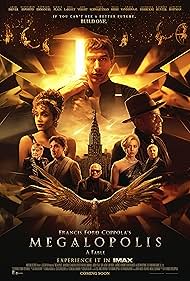It is just the same footage flipped and slightly tilted
Narrative
The city of New Rome faces the duel between Cesar Catilina, a brilliant artist in favor of a Utopian future, and the greedy mayor Franklyn Cicero. Between them is Julia Cicero, with her loyalty divided between her father and her beloved. Francis Ford Coppola wrote the script in the early 1980s, but the film was kept on the back-burner partially due to his financial debts. Pre-production finally began in 2001 after filming 30 hours of second unit footage and holding table read with Paul Newman, Uma Thurman, Robert De Niro, James Gandolfini, Nicolas Cage, Leonardo DiCaprio, Russell Crowe, Edie Falco, and Kevin Spacey, but the project was scrapped after the September 11 attacks, because a scene from the script (page 166) "predicted" the attacks. Coppola fully abandoned the project in 2007, and didn't begin developing it again until 2019.. The security video of Cicero entering Ceasars office is supposed to be two different cameras as indicated by the small text in the upper left corner.
It’s challenging to understand what Coppola’s intention was with this film
Hamilton Crassus III: What do you think about this boner I’ve got?. The "Ultimate IMAX Experience" version of the film features a live actor asking questions during the filmed press conference.. Referenced in The John Campea Show: Adam Driver To Lead Francis Ford Coppola's New Film Megalopolis (2022). My PledgeWritten by Grace VanderWaalPerformed by Grace VanderWaalCourtesy of Columbia RecordsBy arrangement with Sony Music EntertainmentProduced and Orchestrated by Kris Kukul. On one hand, this film has some interesting ideas and visuals, but some ideas never evolve, and some visuals don’t look good. It seems like he chose not to focus too much on characters but rather on themes.
If we remove all the misleading character development, we are left with misleading idea development
However, some scenes suggest that the audience should feel empathy for the characters, but one simply can’t. One reason for that is the pacing of this film; it somehow manages to be fast, yet feel slow, and that might be because some scenes are dull. Megalopolis bombards you with interesting ideas, but because there are quite a few of them, none of them evolves into a solid conclusion. As I already mentioned, it’s hard to see where Coppola was going with all of this.If his intention was to go against the classical narrative structure and challenge viewers with a different type of storytelling, then that didn’t work either. Some scenes contain clichés, and the overall structure feels like a mix of 50s to 90s scenery. One interesting thing the movie does frequently is plant a seed that sometimes does not grow-it stays in that scene, and then we move to the next one.
But it simply does not feel right
This method of storytelling is misleading and confusing for most audiences, and it probably would work better if this technique had a solid foundation throughout the whole film. David Lynch once said that you can make any film, any art the way you want, as long as it feels right. His films are stranger and more difficult to understand than Megalopolis, yet when you watch Lynch’s work, you don’t feel misled-everything feels right, no matter how strange it is. Megalopolis sometimes feels right, sometimes it doesn’t. Megalopolis is a good example of how the director’s stylistic touch matters to the look of the movie. The cinematography of this film was done by the same person who shot The Master.
This film has a shtick to it that I didn’t quite get the first time watching
Yet this film feels like any expensive commercial shot today-too vivid, too warm, too basic.I will definitely rewatch this film in the future, all jokes aside. Overall, it’s a bit sad that this is Coppola’s last film, but I’m sure he has no regrets making it.




 37/12
37/12